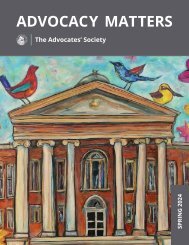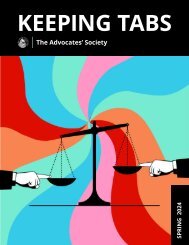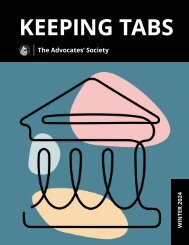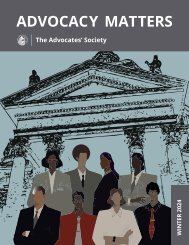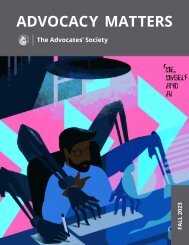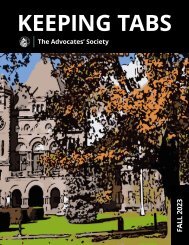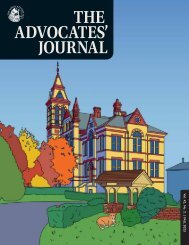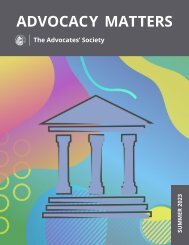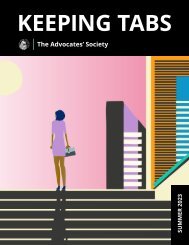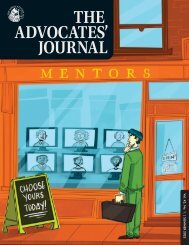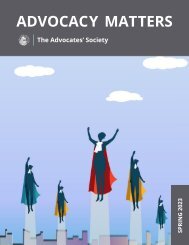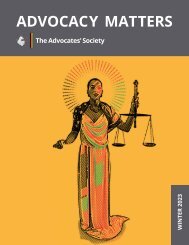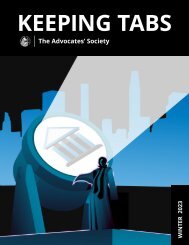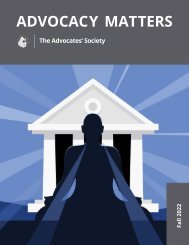Keeping Tabs February 2019
Stay up-to-date on news and events from our Young Advocates' Standing Committee (YASC) with Keeping Tabs.
Stay up-to-date on news and events from our Young Advocates' Standing Committee (YASC) with Keeping Tabs.
You also want an ePaper? Increase the reach of your titles
YUMPU automatically turns print PDFs into web optimized ePapers that Google loves.
KEEPING TABS<br />
The Advocates’ Society<br />
<strong>February</strong> <strong>2019</strong>
CONTENTS<br />
04<br />
06<br />
08<br />
12<br />
15<br />
16<br />
20<br />
22<br />
Chair Chat<br />
Victoria Creighton, Osler, Hoskin & Harcourt LLP<br />
Young Advocates In The News<br />
Compiled by Andrew Eckart, Eckart Mediation and Thomas Milne,<br />
Nahwegahbow Corbiere Genoodmagejig Barristers & Solicitors<br />
Diversity In The Profession:<br />
On The Basis Of Sex<br />
Erin Durant, Borden Ladner Gervais LLP<br />
Access To Justice: YASC At The Pro Bono Hotline<br />
Alexandra Shelley, Torys LLP<br />
YASC Report: Simcoe Fireside Chat<br />
Thomas Milne, Nahwegahbow Corbiere Genoodmagejig Barristers & Solicitors<br />
Diversity of Counsel at the SCC: R. v. Le<br />
Louis Century and Geetha Philipupillai, Goldblatt Partners LLP<br />
Case Comment: Heller v. Uber<br />
David Campbell, The Law Office of David Campbell<br />
Interview: Kyle Ferguson<br />
Compiled by Carlo di Carlo, Stockwoods LLP<br />
Mastering the art and craft of advocacy is a career-long commitment and we are<br />
here to help. The Advocates’ Society has been the premier provider of advocacy<br />
skills training for over 30 years. We are proud to provide lawyers across Canada<br />
with the training and the confidence they need to execute on their feet when it<br />
counts. The Judge will notice…your clients will too.<br />
Visit www.advocates.ca. Be part of the legacy of extraordinary advocates.<br />
25<br />
YouTube Series: Laurie Pawlitza<br />
Erin Durant, Borden Ladner Gervais LLP<br />
Editor: Erin Pleet, Thornton Grout Finnigan LLP | EPleet@tgf.ca<br />
The Young Advocates’ Standing Committee (“YASC”) is a standing committee of The Advocates’ Society with a mandate to be a<br />
voice for young advocates (advocates who are ten years of call or fewer) within the Society and within the profession. We do this<br />
through networking/mentoring events, by publishing articles by and for young advocates, and by raising issues of concern to<br />
young advocates as we work with the Society’s Board of Directors. The opinions expressed by individual authors are their own<br />
and do not necessarily reflect the policies of The Advocates’ Society.<br />
3
COMING UP<br />
(Click on the program to learn more)<br />
CHAIR CHAT<br />
4<br />
Chair Chat<br />
Victoria Creighton, Osler, Hoskin & Harcourt LLP<br />
Last month, I travelled to Ottawa for the President’s Reception and<br />
met with many great Ottawa-based advocates. For the very young advocates<br />
out there, I offer this story for you. This is my seventh year on<br />
YASC and I’m practically a professional event attendee, averaging one or<br />
two events a week. At most events, I spend my time making sure everyone<br />
is chatting in groups. If someone is standing alone, I try my best to<br />
chat with them and find them a group they might find interesting.<br />
At the President’s Reception, I saw a man standing alone, so I walked up and introduced myself.<br />
We chatted for a bit, I told him some silly story about myself, and I then walked with him to a group<br />
of other lawyers, introduced my new friend to the group, then walked on. Walking away, I thought<br />
to myself, “I hope he finds a good conversation. He seems really nice.” I perhaps took another two<br />
steps, only to think, man, that person seems familiar. And then realized it was our new Minister of<br />
Justice. In a room full of lawyers, I was worried that no one was talking to the Attorney General of<br />
Canada. For the record, he was a delight to talk to and, obviously, a kind, patient man.<br />
I offer this story to young advocates everywhere, because, some nights you’re on, you remember<br />
everyone’s name, and all your interactions are smooth. And other nights, well, not so much.<br />
But keep coming out. The profession is largely kind and welcoming. The more you come out, the<br />
easier it gets. My favourite part of being part of TAS is meeting new people, then getting to know<br />
them better event after event. Case in point, I had friends in the room who I could immediately<br />
laugh with about the clumsiness of my own interaction with my new friend David.<br />
In this issue of <strong>Keeping</strong> <strong>Tabs</strong>, you will find an interview with young advocate Kyle Ferguson, a recap<br />
of the Heller decision at the Ontario Court of Appeal, a piece on what lawyers can learn from On The<br />
Basis of Sex to improve diversity in law firms, a feature on our talented young advocate colleagues<br />
already appearing before the Supreme Court of Canada, recaps of YASC events from across Canada,<br />
young advocates in the news, and our continuing TAS “Legends of Bar” video series featuring<br />
former Law Society of Ontario Treasurer Laurie Pawlitza discussing strategies to deal with “imposter<br />
syndrome” in your practice. YASC is always looking for contributions to <strong>Keeping</strong> <strong>Tabs</strong>. If you have<br />
something to say about a case, your life as an advocate, or a great experience at a TAS event, please<br />
tell our acting editor, Erin Pleet at epleet@tgf.ca. If you’re looking to get involved with YASC more<br />
generally, join our Volunteer Roster by emailing Alexandra Shelley at ashelley@torys.com.<br />
MAR 26<br />
Motions Advocacy<br />
Toronto<br />
APR 9<br />
Women in<br />
Litigation<br />
Symposium<br />
Calgary<br />
MAR 6<br />
Peel Pub Night<br />
Mississauga<br />
MAR 29<br />
Leadership Skills<br />
for Litigators<br />
Toronto<br />
APR 10<br />
Women in<br />
Litigation<br />
Symposium<br />
Edmonton<br />
MAR 7<br />
Women in Litigation<br />
Symposium<br />
Ottawa<br />
APR 8<br />
Women in<br />
Litigation<br />
Symposium<br />
Vancouver<br />
MAR 21<br />
Trivia Challenge<br />
for Charity<br />
Toronto<br />
APR 4<br />
Find your Hook:<br />
How To Develop a<br />
Winning Case<br />
Toronto<br />
APR 9<br />
License Appeal<br />
Tribunal (LAT)<br />
Advocacy
IN THE NEWS<br />
Young Advocates in the News<br />
In this feature, we highlight TAS young advocate members in the news. All of the lawyers profiled<br />
have been called to the bar in the last ten years.<br />
If you or a fellow young advocate has had a recent brush with the media about your/their work on<br />
a case, please forward the news story link to:<br />
Andrew Eckart, andrew@eckartmediation.com; or<br />
Thomas Milne, tmilne@nncfirm.ca<br />
• ‘He’s capable of killing me’: PhD student alleges sexual assault by Dominican Republican<br />
official - CBC, October 1, 2018. Megan Savard of Addario Law Group LLP comments on her<br />
client’s sexual assault allegations and ‘powerful’ case against a former member of the Dominican<br />
Republican government.<br />
• Rules on Weed in the Workplace – CBC News Network, October 10, 2018. Jacqueline Luksha,<br />
associate at Hicks Morley Hamilton Stewart Storie LLP, speaks to CBC News Network host John<br />
Northcott about the workplace implications of cannabis legalization.<br />
• City of Regina wants court to quash ruling that allowed Westgate Properties more time to<br />
build – CBC News, October 23, 2018. TAS member and associate at Gowling WLG, Sahil Shoor,<br />
represents Westgate Properties in response to a judicial review launched by the City of Regina.<br />
• POC’s in underrepresented workplaces pressured to speak for entire communities: Global<br />
News, December 26, 2018. TAS member and associate at Nahwegahbow, Corbiere Genoodmagejig<br />
Barristers & Solicitors, Thomas Milne, participates in a panel discussion regarding employment<br />
on Living in Colour.<br />
• Court upholds NPCA board appointments – St. Catharines Standard, December 21, 2018.<br />
Erin Pleet of Thornton Grout Finnigan LLP successfully represented her clients in a dispute<br />
over the governance of the Niagara Peninsula Conservation Authority.<br />
We are #TASProud of our Young Advocates who worked so diligently in raising awareness of<br />
the impending closure of Pro Bono Ontario’s Law Help Centre. The collective effort of many<br />
of our members has helped to ensure that the Law Help Centres will remain in operation<br />
throughout <strong>2019</strong>. The following are some of the news stories that highlight our members’<br />
advocacy efforts:<br />
• Lawyers says loss of Pro Bono Ontario help centres will make justice more difficult and<br />
expensive – The Star, November 6, 2018. TAS member Lindsay Scott, Paliare Roland Rosenberg<br />
Rothstein LLP, discusses the impact of closures of the Law Help Centres.<br />
• Funding pro bono legal services a no-brainer for Ford government – The Star, November<br />
13, 2018. TAS member and associate at Stockwoods LLP, Pam Hrick, provided an opinion<br />
piece encouraging the Ontario government to fund Pro Bono Ontario to prevent the closure<br />
of the Law Help Centres.<br />
• Free civil legal service to close, despite study showing it saves Ontario $5M a year –<br />
CBC News, November 7, 2018. Paliare Roland Rosenberg Rothstein LLP associate Alysha Shore<br />
shares her experiences of volunteering with Pro Bono Ontario over the past 10 years.<br />
TAS Member Erin Durant, associate at Borden Ladner Gervais LLP, was interviewed for several<br />
publications:<br />
• Group trying to keep free legal help centre afloat in Ottawa – CBC Radio (Ottawa Morning),<br />
November 8, 2018.<br />
• ‘You don’t have justice if you don’t have access to a lawyer’: Legal Help Centre to close<br />
– Ottawa Citizen, November 8, 2018.<br />
• Bencher hopefuls push LSO on pro bono funds – Law Times, November 12, 2018.<br />
6 7
DIVERSITY IN THE PROFESSION<br />
A Little Less Conversation,<br />
a Little More Action:<br />
What Lawyers in <strong>2019</strong><br />
Can Learn From On<br />
The Basis of Sex to Improve<br />
Diversity in Law Firms<br />
Erin H. Durant, Borden Ladner Gervais LLP<br />
**Warning: Some Spoilers for the film and some unfiltered thoughts to follow**<br />
On the Basis of Sex is worth the price of admission<br />
both as an entertaining movie and for the lessons<br />
that it teaches the next generation of lawyers<br />
about diversity, advocacy and change.<br />
The film hits its stride when a young Justice Ruth<br />
Bader Ginsburg hears about a case of gender discrimination<br />
against a man. The client was a never<br />
married man whose status and gender made him<br />
ineligible to deduct caregiving expenses for the<br />
care of his ailing mother from his income taxes.<br />
Ruth (as she then was) knew a male litigant would<br />
garner more support from the judiciary than in<br />
prior gender discrimination cases unsuccessfully<br />
advanced by women. The movie covers the<br />
preparation and argument of the case and concludes<br />
with a touching moment which I will not<br />
disclose here (bring tissues).<br />
Other than being an inspiring story, there are<br />
three lessons from the film which I hope will inspire<br />
lawyers to make our workplaces better for<br />
everyone. Here are the lessons.<br />
1. Do Not Make Assumptions Based<br />
On Gender<br />
Ruth is interviewed for many jobs in New<br />
York City. She was top of her class and<br />
a law review leader at Harvard and Columbia.<br />
Yet she was not offered a job at<br />
a private firm. In the film she reflects on<br />
her interview experience, including one<br />
lawyer’s concern that the partners’ wives<br />
might be jealous of a female lawyer.<br />
Unfortunately, these types of gender<br />
related comments are still made<br />
today. During an OCI interview I was<br />
asked about my intentions about having<br />
children. One firm told me “women<br />
had children and did not come back.”<br />
I lost interest in that firm and I expect<br />
they never had interest in me. There<br />
are stories of women lawyers with busy<br />
starts to their career who return from<br />
maternity leave to find they have no<br />
files. Some people assume women with<br />
children do not want to attend certain<br />
client networking opportunities outside<br />
of office hours – yet are quick to invite<br />
men with children to the same events.<br />
All of these experiences have an impact<br />
on women lawyers and their ability to<br />
succeed in the profession.<br />
The “traditional” gender roles that<br />
were changing when RBG started her<br />
career have largely changed now. We<br />
cannot let preconceived notions about<br />
an individual’s responsibilities outside<br />
of the office impact how we treat those<br />
people in the office and what opportunities<br />
we give them. Those notions<br />
should have ended decades ago.<br />
2. Don’t Just be Part of a Support Group<br />
Ruth’s inspiring daughter Jane had a<br />
number of memorable moments in the<br />
film. The highlight for me was when<br />
Jane says: “It’s not a movement if every-<br />
8 9
one’s sitting down. It’s a support<br />
group.”<br />
In 2016 in Ontario women<br />
made up 54.3% of lawyers under<br />
the age of 35 and 52% of<br />
lawyers between the ages of<br />
35 and 44. The increase in the<br />
number of women in the profession<br />
is not resulting in a<br />
corresponding increase in the<br />
number of women admitted to<br />
partnership. While it is difficult<br />
to secure accurate data on the<br />
number of women partners<br />
in Canadian law firms, in the<br />
United States the latest NALP<br />
diversity report indicates that<br />
women accounted for 23.36%<br />
of partners in law firms they<br />
surveyed in 2018 (slightly up<br />
from 22.7% in 2017) even<br />
though women have made<br />
up approximately half of law<br />
school graduates over the past<br />
20 years and made up approximately<br />
45.5% of associates as<br />
of 2017. The percentage of visible<br />
minority partners is even<br />
lower – at less than 10%. These<br />
figures suggest that law firms<br />
are not promoting diverse candidates<br />
in equal proportion to<br />
the number of diverse candidates<br />
in the profession. Some<br />
law firms are recognizing that<br />
this is a problem and are taking<br />
steps to address the diversity<br />
in their partnership.<br />
Women and minorities talk<br />
privately when there is a perceived<br />
lack of diversity in promotions.<br />
It bothers them. These<br />
concerns are often raised at<br />
events and conferences designed<br />
for and attended by<br />
them. But law firm leaders and<br />
decision makers are not always<br />
there. I worry that these<br />
events are support groups, not<br />
movements. Until key decision<br />
makers are brought into the<br />
discussion, little will change.<br />
The statistics show that we<br />
need a movement, not a support<br />
group.<br />
3. Be Strategic<br />
Ruth Bader Ginsberg created<br />
the Women’s Rights Project to<br />
increase the pace on improving<br />
equality in America for<br />
women. The Project systematically<br />
targeted laws which<br />
discriminated on the basis<br />
of sex and approached their<br />
work one case at a time. It was<br />
a tremendous success as the<br />
project pushed forward 300<br />
sex discrimination cases in the<br />
1970s and had numerous victories<br />
in the Supreme Court.<br />
The Women’s Rights Project<br />
continues to this day with focuses<br />
on women in education,<br />
violence against women,<br />
women in criminal justice and<br />
women’s rights in the workplace.<br />
Law firm culture will not<br />
change overnight. Concrete<br />
strategies are required to improve<br />
diversity and inclusion.<br />
Many steps that are required<br />
are outside of the control of<br />
the young lawyers who read<br />
<strong>Keeping</strong> <strong>Tabs</strong>. Research shows<br />
that leadership on diversity<br />
and inclusion must come from<br />
the top. I agree.<br />
However, Ruth Bader Ginsberg<br />
did not wait for change<br />
to come. She strategically<br />
forced the issue. Here are<br />
some of my strategies which<br />
young lawyers can use to help<br />
improve diversity and inclusion<br />
in their firms:<br />
1. Speak Up: Voice concerns<br />
about diversity and inclusion<br />
in your workplace. Ask what<br />
is being done. Ask for the<br />
deadlines. Follow up. Volunteer<br />
to help.<br />
2. Create Diverse Teams<br />
Around You: When you are<br />
in a position to delegate work –<br />
create your own diverse teams.<br />
Give diverse students opportunities.<br />
Be mindful of your own<br />
unconscious biases. Make an<br />
effort to work with people who<br />
are not like yourself.<br />
3. Insert Yourself and be an<br />
Advocate for Others: Be vocal<br />
about wanting to be included<br />
in client and networking opportunities.<br />
Do not wait to be<br />
approached. Voice interest in<br />
being involved in the next big<br />
file that matches your skill set.<br />
Be an advocate for others if<br />
you notice diverse lawyers are<br />
not considered for opportunities<br />
and if client teams are not diverse.<br />
Not everyone notices a<br />
lack of diversity (yet). Constant<br />
reminders help.<br />
4. Push the Marketing Department:<br />
Advise your marketing<br />
department of your<br />
interest in being included in<br />
RFPs, marketing materials and<br />
lawyer rankings. When reviewing<br />
marketing materials, advise<br />
when there is a lack of diversity<br />
in the materials.<br />
5. Do Not Tolerate Discrimination:<br />
Law firms are required<br />
to have non-discrimination policies.<br />
If you notice discrimination,<br />
report it. If you do not feel<br />
comfortable reporting it, have<br />
your mentor do it.<br />
After watching On the Basis of<br />
Sex I was motivated to do more<br />
to promote diversity within the<br />
legal profession. I hope that<br />
you watch the film and it inspires<br />
you to do the same.<br />
Disclaimer: The above thoughts<br />
are my personal suggestions<br />
on how to help create change.<br />
They are not a solution; there<br />
is no one single, right way that<br />
any of us can make the profession<br />
and law firms more inclusive<br />
alone. It will take time<br />
for firms, the legal profession,<br />
and biases of society-at-large<br />
to catch up. What we can do,<br />
in the interim, is keep these<br />
issues in the forefront and do<br />
what we can as individuals<br />
along the way.<br />
10 11
ACCESS TO JUSTICE<br />
YASC Answers the<br />
Call at the Pro Bono<br />
Ontario Hotline<br />
Alexandra Shelley, Torys LLP<br />
Courthouse Series <strong>2019</strong><br />
The Effective Witness<br />
Cases stand and fall on witness credibility. Attend this year's Courthouse Series and learn<br />
how to get the most out of all witnesses. This year's series will feature an outstanding<br />
cast of experienced advocates sharing practical strategies for preparing, controlling and<br />
examining different types of witnesses.<br />
Kingston<br />
<strong>February</strong> 28, <strong>2019</strong><br />
Barrie<br />
March 7, <strong>2019</strong><br />
Sudbury<br />
March 21, <strong>2019</strong><br />
Hamilton<br />
May 8, <strong>2019</strong><br />
In furtherance of YASC’s mandate to increase access to justice, during the week of<br />
December 3, 2018, members of YASC, their colleagues, and members of the YASC<br />
Volunteer Roster volunteered with the Pro Bono Ontario Hotline. The volunteers each<br />
spent a day at the PBO Hotline answering calls from Ontarians and providing summary<br />
legal advice on a range of topics from landlord tenant issues to intellectual property<br />
infringements.<br />
The Hotline currently receives over 350 calls a day and each YASC volunteer was able<br />
to help as many as 10 clients per day. Since its launch in September 2018, the Hotline<br />
has provided access to legal advice for thousands of Ontarians with everyday civil legal<br />
problems. PBO volunteers filled 864 shifts at the Hotline in 2018 and helped nearly<br />
15,000 callers.<br />
If you’re interested in getting involved with the Hotline, please contact Nicole<br />
Kellow at hotlineschedules@probonoontario.org or 416-977-4448 ext. 926.<br />
Windsor<br />
<strong>February</strong> 28, <strong>2019</strong><br />
Owen Sound<br />
March 5, <strong>2019</strong><br />
London<br />
March 7, <strong>2019</strong><br />
Thunder Bay<br />
March 7, <strong>2019</strong><br />
Milton<br />
April 29, <strong>2019</strong><br />
Ottawa<br />
April 29, <strong>2019</strong><br />
LEARN MORE OR REGISTER<br />
Kitchener<br />
May 9, <strong>2019</strong><br />
Kitchener<br />
May 16, <strong>2019</strong><br />
12 13
YASC REPORT<br />
YASC’s First Simcoe<br />
County Fireside Chat<br />
Thomas Milne,<br />
Nahwegahbow Corbiere Genoodmagejig<br />
Barristers & Solicitors<br />
Your Next<br />
Challenge Is Here<br />
The Advocates’ Society Career Board is the only legal<br />
job board created just for the litigation bar. Access<br />
notices for litigation, ADR and judicial vacancies that<br />
are exclusively listed for advocates across Canada.<br />
To find your next position visit www.advocates.ca<br />
On December 12, 2018, a Fireside Chat on Advocacy<br />
was held in Simcoe County featuring Mr.<br />
David C. Nahwegahbow. The event took place<br />
at Casino Rama and was generously sponsored<br />
by Nahwegahbow, Corbiere Genoodmagejig,<br />
Barristers & Solicitors, Oatley Vigmond Personal<br />
Injury Lawyers LLP, and Carroll Heyd Chown<br />
LLP. Mr. Nahwegahbow was interviewed by<br />
Professor Jeffery Hewitt from the University of<br />
Windsor, Faculty of Law.<br />
It was a very special evening. Mr. Nahwegahbow<br />
is widely recognized as an expert in<br />
Indigenous law and has long been an outstanding<br />
role model for Indigenous lawyers<br />
throughout Canada. He spoke about his<br />
background, his early beginnings as a legal<br />
advocate, his work on a Child Welfare case<br />
currently before the Canadian Human Rights<br />
Tribunal, and his work on a treaty interpretation<br />
case involving the Robinson-Huron<br />
Treaty of 1850 currently before the Ontario<br />
Superior Court of Justice.<br />
YASC looks forward to hosting more events<br />
in Simcoe County.<br />
15
DIVERSITY OF COUNSEL AT THE SCC: R. v. Le<br />
Disrupting unspoken<br />
notions about who ‘belongs’<br />
at the Supreme Court<br />
Louis Century and Geetha Philipupillai,<br />
Goldblatt Partners LLP<br />
At the hearing of R. v. Le in October 2018, the Supreme Court of<br />
Canada considered the question of whether a reasonable expectation<br />
of privacy extends to social visits in a friend’s backyard. The<br />
backyard in question was at a downtown Toronto Housing Co-operative<br />
where the appellant Tom Le and his friends, all young men<br />
of colour, had grown up and where the police have an active presence.<br />
On the night of Mr. Le’s arrest, he was socializing in his friend’s<br />
backyard when three police officers entered the backyard, uninvited,<br />
and questioned Mr. Le and the group, leading to Mr. Le’s arrest<br />
and the seizure of a firearm, currency and drugs.<br />
Mr. Le was represented by Emily Lam (Kastner<br />
Law, 2008) and Samara Secter (Addario<br />
Law, 2014), who urged the Court to account<br />
for the lived experience of racialized youth<br />
when approaching the question of an expectation<br />
of privacy in this context. The judgment,<br />
which is under reserve, could change<br />
the law of search and seizure in Canada. Yet<br />
regardless of the outcome, the case already<br />
stands out for another reason.<br />
The hearing itself was both younger and<br />
more diverse than any Supreme Court hearing<br />
in the recollection of these authors. Thirteen<br />
out of the 23 listed counsel were ‘young<br />
advocates’ (within their first ten years of practice),<br />
including five out of 11 speaking lawyers.<br />
Fifteen out of 23 counsel were women.<br />
And for a case that concerned the experience<br />
of young racialized people with law enforcement,<br />
many of the lawyers before the Court<br />
were themselves racialized. Some, like<br />
Mr. Le’s lawyer Emily Lam, grew up in<br />
the same neighbourhood where Mr. Le<br />
and his friends were socializing when<br />
this case began.<br />
Counsel at Supreme Court hearings<br />
are disproportionately senior, white and<br />
male, but not this time. We decided to<br />
speak with some of the all-star young<br />
advocates in this case about why a representative<br />
courtroom matters to them.<br />
#Womeninlaw at the Supreme Court<br />
Danielle Glatt (Lenczner Slaght Royce<br />
Smith Griffin LLP, 2014), co-counsel for<br />
the Canadian Civil Liberties Association,<br />
recalled that the robing room was full<br />
of women in the morning before the<br />
case. “In appellate litigation, that was a<br />
first for me, for it to be majority women,”<br />
she said. Lindsay Board (Stockwoods<br />
LLP, 2016), co-counsel for the<br />
Federation of Asian Canadian Lawyers<br />
and the Chinese and Southeast Asian<br />
Legal Clinic, concurred: “As someone<br />
relatively early in her career, it definitely<br />
made a difference for me to see so<br />
many women doing an incredible job.”<br />
Dayna Steinfeld (Fillmore Riley LLP,<br />
2013), co-counsel for Canada Without<br />
Poverty et al, said, “Participating in the<br />
Le case as an advocate made me feel<br />
hopeful that there is space for lawyers<br />
who are different. Watching two young<br />
female advocates [Emily Lam and Samara<br />
Secter] argue the entire case for<br />
the Appellant was incredibly meaningful<br />
for me as a young female advocate<br />
myself.” Similarly, Tina Lie (Paliare Roland<br />
Rosenberg Rothstein LLP, 2007),<br />
co-counsel for Scadding Court Community<br />
Centre, said the case was a “reminder<br />
to young, female and racialized<br />
litigators that we are not imposters or<br />
intruders; we can and do belong in a<br />
16 17
space like the Supreme Court<br />
of Canada.”<br />
Racial representation of<br />
counsel<br />
For Anthony Morgan (then at<br />
Falconers LLP and now with the<br />
City of Toronto, 2013), who represented<br />
the Urban Alliance on<br />
Race Relations, “The roster of<br />
counsel in this case positively<br />
disrupts the unspoken notion<br />
that young and/or racialized<br />
people and perspectives don’t<br />
belong among the highest<br />
rungs of our profession.”<br />
Mr. Morgan contrasted this<br />
case to his previous experience<br />
at the Supreme Court in<br />
R. v. Nur, which concerned a<br />
mandatory minimum sentence<br />
involving a Black accused. Besides<br />
the accused, Mr. Morgan<br />
was the “the only Black person”<br />
there and, besides his co-counsel<br />
Faisal Mirza, counsel did not<br />
even “[use] the word ‘Black’ or<br />
‘African-Canadian’ in their oral<br />
submissions.” Mr. Morgan felt<br />
“an unsettling mix of great joy<br />
and emotional pain at reaching<br />
a professional pinnacle” and<br />
said, “I can’t think of a time that<br />
I felt more simultaneously visible<br />
and invisible as a lawyer.”<br />
In contrast, Mr. Morgan said<br />
about R. v. Le, “I am heartened<br />
and hopeful about how different<br />
the composition and<br />
character of the submissions<br />
were in R. v. Le than in R. v. Nur.<br />
While there’s still a long way to<br />
go, the change gives me some<br />
hope that we, as a legal profession<br />
are steadily headed in the<br />
right direction.”<br />
The courtroom is for<br />
the people<br />
Tina Lie similarly said, “In this<br />
case, the appellant and many<br />
of the interveners were able<br />
to advance their diverse perspectives<br />
through counsel who<br />
looked and sounded like them,<br />
in some cases grew up in neighbourhoods<br />
close to or similar to<br />
the one in which the appellant<br />
was arrested and, importantly,<br />
understand what it is like to<br />
navigate our society as a member<br />
of a minority group.”<br />
Ms. Lie’s co-counsel Lauren<br />
Pearce (2016) continued, “This<br />
not only gives important context<br />
to counsel’s legal arguments,<br />
it also helps to provide<br />
a perspective that might otherwise<br />
not be voiced, and hopefully<br />
leaves litigants feeling like<br />
they were meaningfully heard<br />
(regardless of the outcome).”<br />
Emily Lam said, “The courtroom<br />
is for the people, and<br />
should represent those who<br />
come before the law. If judges<br />
and courtrooms don’t reflect<br />
the people they serve, trust<br />
and faith in the system is diminished.<br />
A diversity of experience<br />
makes the system better<br />
and opens the door to different<br />
perspectives and ways of<br />
considering issues that we<br />
might not otherwise think of if<br />
the courtroom and bench were<br />
more homogenous.”<br />
Diversity on the bench<br />
In contrast to the diverse composition<br />
of counsel in this case,<br />
the judges who will decide the<br />
case are all white, as has been<br />
the case since 1875 when the<br />
Supreme Court was founded.<br />
When asked why a representative<br />
bench matters, Ms. Secter<br />
said, “it is difficult to understand<br />
the humiliation of being<br />
‘othered’ by the police, or<br />
asked if you belong in a certain<br />
place, unless you have lived it.<br />
If you are always in the majority,<br />
being on the outside is a<br />
completely unknowable experience.”<br />
Several counsel recalled an<br />
exchange in which Faisal Mirza<br />
asked the Court to imagine the<br />
police walking into the backyard<br />
of “some of the icons of<br />
criminal law…Greenspan, Moldaver,<br />
Rosenberg and Gold.”<br />
Justice Moldaver interjected,<br />
“I’d invite them to have a<br />
drink.” Mr. Mirza later said this<br />
exchange “crystallized the difference”<br />
between how different<br />
members of society experience<br />
police interactions.<br />
Gerald Chan (Stockwoods<br />
LLP, 2008) also reflected on the<br />
importance of a diverse bench:<br />
“Judges approach cases with an<br />
open mind, but not an empty<br />
mind. They are all informed, and<br />
to some extent limited, by their<br />
own experiences. The more<br />
diverse the judiciary – and, on<br />
appeals, the hearing panel –<br />
the better their judgments will<br />
be. That’s over and above the<br />
benefits to public confidence of<br />
having a judiciary that reflects<br />
the population it serves.”<br />
All-star appellate duo<br />
For Ms. Lam and Ms. Secter,<br />
this was a ‘dream opportunity’<br />
to work together on such an<br />
important case. Ms. Lam called<br />
Ms. Secter “one of the funniest<br />
and brightest lawyers I<br />
know” and said, “I believe I had<br />
an opportunity many lawyers<br />
dream about: I got to work on<br />
a case involving issues that I<br />
deeply care about with people<br />
who share the same personal<br />
and professional principles<br />
I do.” Ms. Secter agreed that<br />
working with Ms. Lam made<br />
the case special and unforgettable:<br />
“She is a smart and dedicated<br />
advocate. She knows<br />
how to connect with people<br />
from all walks of life.”<br />
For Ms. Lam, who represented<br />
Mr. Le at the lower courts<br />
as well, a favourable decision<br />
would have personal resonance.<br />
She said, “I grew up in the same<br />
neighbourhood as Mr. Le many,<br />
many years ago. It’s a pretty<br />
unique experience to be able<br />
to personally understand some<br />
of the challenges people in the<br />
community face, and to be able<br />
to advocate for changes to the<br />
way the constitutional rights<br />
of marginalized and racialized<br />
groups are understood. If we’re<br />
successful in this case, the law<br />
as it would have applied to me<br />
when I was growing up in the<br />
community…will have changed<br />
for the better!”<br />
Judgment was reserved at<br />
the Supreme Court and a decision<br />
is pending.<br />
18 19
CASE COMMENT<br />
One Heller of an<br />
Arbitration Agreement<br />
David Campbell,<br />
The Law Office of David Campbell<br />
Arbitration is becoming ever-more important for those who practise civil litigation,<br />
since an ever-increasing number of contracts contain arbitration agreements.<br />
For those interested in arbitration, the Ontario Court of Appeal started <strong>2019</strong> with a<br />
bang. Heller v. Uber Technologies Inc. is one of those rare cases where the arbitration<br />
agreement was held to be unconscionable. The case also held that the arbitration<br />
agreement was invalid because it violates s. 5(1) of the Employment Standards Act,<br />
2000 (ESA). The Court’s unconscionability findings should bolster public confidence in<br />
arbitration by refusing to enforce an ADR clause that would effectively prevent the<br />
dispute from being decided independently and beyond judicial overview.<br />
Heller is a 35-year-old, high-school-educated UberEATS driver who earns $400–$600<br />
a week—or $20,800–$31,200 a year—working<br />
40–50 hours a week. This income is before<br />
taxes and expenses, like his vehicle.<br />
He commenced a proposed class action on<br />
behalf of all Uber drivers seeking a declaration<br />
that they are employees under the ESA,<br />
and $400 million in damages.<br />
Uber’s contracts with their drivers have<br />
arbitration agreements. Uber moved under<br />
s. 7(1) of the Arbitration Act, 1991 and<br />
Article 8(1) of the International Arbitration<br />
Act, 2017 (ICAA) to stay Heller’s action.<br />
Both provisions mandate a stay, absent<br />
certain exceptions. The Court of Appeal’s<br />
analysis focuses on s. 7(2)(2.): “The arbitration<br />
agreement is invalid.”<br />
At the heart of this case is Uber’s ADR<br />
system. If a driver has dispute with Uber,<br />
then there are several steps:<br />
• The driver starts by calling an Uber<br />
CSR in the Philippines;<br />
• The dispute may then be referred to<br />
an Uber CSR in Chicago;<br />
• Uber’s legal team may then take over<br />
the dispute from the Chicago CSR;<br />
• The driver may also go to an Uber<br />
Greenlight Hub in Ontario to ask Uber<br />
staff for help;<br />
• If still dissatisfied, the driver may commence<br />
a mediation with the International<br />
Chamber of Commerce (ICC) in<br />
the Netherlands under Dutch law; and<br />
• If the mediation fails, the driver may then<br />
commence an ICC arbitration, again in<br />
the Netherlands under Dutch law.<br />
Aside from travel and counsel fees, the<br />
driver would have to pay $14,500 (USD) in<br />
ICC filing fees to reach arbitration, along<br />
with his or her share of the mediator’s<br />
and arbitrator’s fees.<br />
The Court found that this arbitration<br />
agreement was unconscionable, because<br />
“it operates to defeat the very claims it purports<br />
to resolve.” The Court held that the<br />
facts were sufficient to meet both the twopart<br />
test for unconscionability and the fourpart<br />
test. A driver with a claim of a few hundred<br />
dollars must fly to the Netherlands to<br />
have his or her claim decided independently,<br />
rather than by Uber employees.<br />
In a separate holding, the Court also held<br />
that the arbitration agreement violates s.<br />
5(1) of the ESA and is thus unenforceable.<br />
Section 5(1) of the ESA voids provisions that<br />
force an employee to contract out or waive<br />
an employment standard. Not only does<br />
Uber’s arbitration agreement extinguish<br />
an employee’s right under s. 96 to report a<br />
dispute to the Ministry of Labour and have<br />
an Employment Services Office investigate,<br />
but it also eliminates an employee’s s. 98<br />
right to commence a civil action. According<br />
to the Court, arbitration does not fall within<br />
the definition of a civil action.<br />
However, the ESA analysis has a tricky<br />
component. It presumes that Heller’s allegation<br />
that he is an employee is capable<br />
of proof. This presumption is based<br />
on the Supreme Court of Canada’s decision<br />
in Seidel v. TELUS Communications Inc.<br />
Although Seidel certainly makes the same<br />
presumption, this is the first case following<br />
Seidel that uses the presumption in<br />
the context of a stay motion. It does seem<br />
to leave open the possibility that future<br />
plaintiffs could make questionable allegations<br />
to defeat s. 7(1).<br />
Generally, arbitration agreements<br />
must be enforced, even in contracts of<br />
adhesion, unless one of the exceptions<br />
in s. 7(2) or Article 8(1) is met, the dispute<br />
is outside the scope of the arbitration<br />
agreement, or there is a legislative<br />
override to the arbitration. In promoting<br />
arbitration as an alternative, we must<br />
not allow ourselves to enforce unconscionable<br />
arbitration agreements that<br />
may undermine public confidence in arbitration<br />
as a fair and legitimate form of<br />
dispute resolution.<br />
20 21
Do you know a young advocate who we<br />
should feature in an upcoming Interview?<br />
Click here to email us with your suggestion.<br />
Q. What is your year of call?<br />
A. 2012 in Ontario and<br />
2014 in B.C.<br />
Q. What is your greatest fear in practice?<br />
A. The spectre of missing a deadline or limitation<br />
period is something that I think we all fear.<br />
Q. Which word do you prefer: litigator or advocate?<br />
A. The term litigator is certainly used more often, but I think advocate best captures the work that<br />
we do inside and outside the courtroom to organize, refine and present our clients’ cases.<br />
Q. What is your favourite take out cuisine?<br />
A. Pizza and beer.<br />
Q. If you weren’t a lawyer<br />
what would you be?<br />
A. I think I would have wanted to<br />
be a professor or teacher.<br />
INTERVIEW<br />
In conversation<br />
with Kyle Ferguson,<br />
Gudmundseth Mickelson LLP, Vancouver<br />
Compiled by Carlo di Carlo, Stockwoods LLP<br />
Q. Which living lawyer do you most admire?<br />
A. There are so many lawyers that I work alongside or against that I admire, so rather than singling<br />
out one of them, I will go a different route and pick Beverley McLachlin. She was the face of the<br />
Supreme Court for a generation, and the clarity of her jurisprudence from all levels of court on<br />
which she served continues to resonate here in B.C.<br />
Q. What is your favourite case?<br />
A. Whenever I revisit Roncarelli v. Duplessis, I am struck by Justice Rand’s eloquent articulation of<br />
the limits on government action and the exercise of discretion. His cogent explanation of the rule<br />
of law continues to apply to situations faced by our clients.<br />
Q. Why did you become a litigator or advocate?<br />
A. I didn’t go into law school with a fixed idea of my intended area of practice, but after being<br />
exposed to litigation while summering at a law firm after my first year of law school, I was hooked.<br />
Q. What is the latest non-legal book<br />
you’ve read?<br />
A. Tommy Orange’s There There.<br />
Q. Which talent would you most like to<br />
have?<br />
A. I wish I could sleep on planes!<br />
Q. What do you like most about your practice?<br />
A. I enjoy the process of learning the ins and outs of our clients’ businesses or circumstances,<br />
organizing their sometimes complicated facts in a way that can be presented to<br />
the court, and figuring out how the law responds to their legal issues.<br />
Q. From whom have you learned the most about the practice of law?<br />
A. The senior lawyers that I work with, Stein Gudmundseth, Q.C., Howard Mickelson,<br />
Q.C., Andrew Gay, Q.C. and Lisa Martz. They are incredibly generous with their time<br />
and are a daily source of wisdom, advice and opportunities.<br />
22 23
Q. What unique knowledge have you gleaned in your practice that you can share with<br />
other young advocates?<br />
A. There is a famous quote from Robert Jackson about the three arguments he made in every<br />
case as Solicitor General of the United States: the one he planned for, the one he actually presented,<br />
and the “utterly devastating” argument that he thought of after going to bed that night.<br />
Whether it’s an examination of a witness or an oral submission, in the hours, days or weeks that<br />
follow you might think of an answer that you wish you had given, or a further question that you<br />
wish you had asked a witness. This doesn’t happen only to young advocates so you shouldn’t be<br />
too hard on yourself. Instead, use these as opportunities to learn.<br />
Q. What is your greatest extravagance<br />
in your everyday life?<br />
A. I like to pick up a decent bottle of wine<br />
every now and then. Another “extravagance”,<br />
though certainly not an everyday<br />
one, is collecting works by emerging artists.<br />
Our artists tend to be underappreciated<br />
in this country, and I encourage<br />
everyone to support these folks in their<br />
regions and beyond. They promote curiosity,<br />
inspire debate, and encourage dialogue<br />
in ways concrete and abstract, and<br />
they certainly deserve our support.<br />
Q. You practised in both Toronto and<br />
Vancouver. What is the difference in<br />
the practice between the two cities?<br />
A. For me, the biggest difference was the<br />
change in subject matter. In Toronto, my<br />
practice involved primarily patent and<br />
trademark disputes, whereas my practice<br />
now is much more general. Aside from<br />
that, there is certainly a difference in the<br />
size of the bar, but both are collegial and<br />
filled with talent.<br />
YOUTUBE SERIES<br />
TAS Legends of the Bar<br />
Erin H. Durant, Borden Ladner Gervais LLP<br />
Pawlitza Discusses Imposter Syndrome in the Practice of Law<br />
and How to Believe in Yourself<br />
Q. What should advocates in the rest of Canada know about the life of a litigator in Vancouver?<br />
A. There are a lot of great opportunities for young lawyers in Vancouver. The breadth of files, big<br />
and small, allow young lawyers here to gain courtroom experience and develop their skills early<br />
on in their careers. The bar is small enough that you will regularly run into the same lawyers, and<br />
so your reputation is especially important.<br />
The TAS archives contain footage<br />
from a number of CPD conferences,<br />
including the 2011<br />
Women in Litigation Conference.<br />
Laurie Pawlitza gave a significant<br />
speech at this event - a portion<br />
of which focused on imposter<br />
syndrome and strategies to get<br />
over the feeling that you do not<br />
belong or are not good enough<br />
to accomplish your goals. Imposter<br />
syndrome impacts many<br />
in the practice of law including<br />
women, minorities and first<br />
generation lawyers. Watch Ms.<br />
Pawlitza discuss her own battle<br />
with imposture syndrome and<br />
her suggestions on how to silence<br />
the negative voice that can<br />
hold you back.<br />
24<br />
25
Toronto Pub Night<br />
Wednesday, January 16, <strong>2019</strong> | Irish Embassy Pub & Grill, Toronto<br />
OTTAWA PRESIDENT’S RECEPTION<br />
Thursday, January 31, <strong>2019</strong> | The Rideau Club, Ottawa<br />
The Honourable David Lametti, Minister of Justice and Attorney General of Canada<br />
Anne M. Turley, Department of Justice<br />
The Honourable David Lametti,<br />
Minister of Justice and Attorney General of Canada<br />
26 27
FIRESIDE CHAT: MENTAL RESILIENCE IN LITIGATION<br />
Thursday, January 31, <strong>2019</strong> | The Vancouver Club, Vancouver<br />
The 5th Annual Kingston Trivia Challenge<br />
Thursday, <strong>February</strong> 7, <strong>2019</strong> | The Kingston Brewing Company, Kingston<br />
Allison Wolf, Lawyer Coach, Shift Works Strategic Inc, Kaitlyn Meyer, Hakemi Ridgedale LLP, and Brook Greenberg,<br />
Bencher of the Law Society of British Columbia, Partner at Fasken Martineau DuMoulin LLP<br />
28 29
ARNUP CUP<br />
<strong>February</strong> 8-9, <strong>2019</strong> | TAS Education Centre, Toronto<br />
CARTOON<br />
OH NO!<br />
What’s<br />
happening?<br />
Oh man! I have no<br />
idea what’s going on.<br />
LEGENDARY<br />
GENIUS!!!<br />
Um …Ob-objection?<br />
Sustained.<br />
Arnup Cup Winner: Lakehead University - (From left to right) Witness Eric Blay, Austin Nix, Phaedra Olinyk,<br />
Oralist Nathan Wainwright, Oralist Amanda Gallo.<br />
Are you a TAS member
www.advocates.ca




